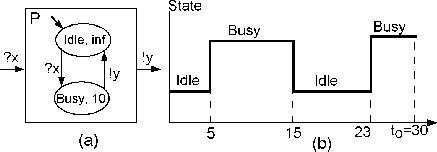 |
P as
shown in Figure 4.2(a) which has two states:
Busy, which is defined as working time, and Idle,
which is defined as ``running, but not working'' time. Once it
receives an input ?x, it processes the input and then
generates output !y after 10 time units. Figure
4.2(b) illustrates a state trajectory of the
processor terminating at Busy is (15-5)+(30-23)=17, so utilization of
the processor is 56.7%=(17/30)*100, while idle's
percentage is 100-56.7=43.3%.
We can generalize this concept to more than two states. Let's consider the vending machine introduced in Section 3.1.2. Suppose that we have a state trajectory of the vending machine as shown in Figure 4.3. This state trajectory can be seen as a sequences of piece-wise constant segments. The time it takes to transition between states is assumed to be zero.
The time duration of a piece-wise constant segment is defined by
![]() where
where
![]() is a set
of natural numbers. This function maps from state
is a set
of natural numbers. This function maps from state ![]() and the
order
and the
order
![]() of a segment piece to a time span value
if the segment piece in the state
of a segment piece to a time span value
if the segment piece in the state ![]() , otherwise the value is 0.
For example, in the state trajectory of Figure 4.3,
, otherwise the value is 0.
For example, in the state trajectory of Figure 4.3,
![]() , while
, while
![]() because
of the state of the second segment is
because
of the state of the second segment is Wait.
Let ![]() be the current state. Then the probability that the
current state is
be the current state. Then the probability that the
current state is ![]() over time from 0 to
over time from 0 to ![]() , denoted by
, denoted by
![]() , is
, is
It is true that
 |
(5.4) |
 |
(5.5) |
Idle) = (5+3+10)/40 = 0.45, Wait) =
(15+5)/40 =0.5, O_pepsi)=2/40 =0.05,
O_coke)=0.
Idle) and
Busy) over time [0,50].